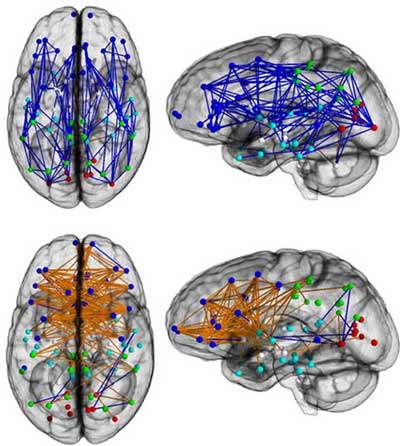And the latest research shows...

Connectivity: The Difference Between Men’s and Women’s Brains

Male brains (top) show greater connectivity front-to-back, while female brains (bottom) are more connected across the hemispheres.
A fascinating study on the brains of 949 young people finds striking gender differences in the brain’s connectivity between males and females (Ingalhalikar et al., 2013). These may help explain some of the classic psychological differences between men and women.The study uses a type of brain imaging–diffusion tensor imaging–which can reveal the microscopic structures of the living brain. From the 428 males in the study, the researchers found that the connections in men’s minds ran more between the front and the back, within the same half of the brain.
This may help to explain men’s advantage with motor and spatial skills over women since front-to-back connections help link perception with action. In the brains of the 521 females in the study, the researchers noted more overall connections between the two hemispheres of the brain. This may help explain women’s improved memory and social skills, the authors argue, since communication between the halves of the brain helps link intuition with analysis.
Differences emerge at 13
The participants in the study were aged between 8 and 22-years old, as the researchers were looking for clues about how the brain develops. They found that there were few differences between males and females before the age of 13, but that the different patterns of connectivity kicked in at puberty.
One of the study’s authors, Ruben Gur commented: “It’s quite striking how complementary the brains of women and men really are. Detailed connectome maps of the brain will not only help us better understand the differences between how men and women think, but it will also give us more insight into the roots of neurological disorders, which are often sex related.”
Source: Dr Jeremy Dean, Psyblog
Image credit: Ragini Verma, Ph.D., Proceedings of National Academy of Sciences
Like to Stay Up Late? Different Neural Structures Found in the Brains of Night Owls

For the first time differences in neural structures have been shown between people who are night owls and early risers.
In research on 59 participants, those who were confirmed night owls (preferring late to bed and late to rise) had lower integrity of the white matter in various areas of the brain (Rosenberg et al., 2014).
Lower integrity in these areas has been linked to depression and cognitive instability.
This research doesn’t tell us what the relationship is, but the authors guess that it may be related to ‘social jet-lag’. Social jet-lag comes about because night owls are forced to live–as most of us are–like early risers. Work, school and other institutions mostly require early rising, which, for night owls, causes problems.
As night owls find it difficult to get to sleep early, they tend to carry large amounts of sleep debt. In other words, they’re exhausted all the time.
As a result, they tend to be larger consumers of caffeine and other stimulants, in order to counteract their sleep debt.
Who’s a night owl?
Night owls make up around 20% of the population, with about 10% of us being larks–preferring to sleep early and rise early.
The rest of us are balanced in-between. This means about 70% should be able to adapt to either rising early or sleeping later, as long as they stick to good sleep habits .
Men are more likely to be night owls–this seems to be related to higher levels of testosterone. This is why adolescent males have the tendency to be extreme night owls, staying up all night and sleeping in all day.
Naturally, then, women, along with the elderly of both sexes, are more likely to be larks.
Source: Dr Jeremy Dean, Psyblog
Image credit: Ryan Ritchie
Neuroscience Reveals The Deep Power of Human Empathy

Without empathy, human beings are lonely, disconnected creatures.
An old philosophical question asks: is there any such thing as a selfless act?
Cynics answer no, because any apparently selfless act is always tacitly showing off what ‘good’ people we are.
Even if no one else knows about the act, the good feeling you get yourself from helping someone else means a selfless act is never really entirely selfless.
But perhaps cynics will be impressed by recent neuroscientific studies which demonstrate in the living mind the enormous human capacity for empathy.
Holding hands
In an experiment, participants were first put in an fMRI machine and shown a series of ‘X’s and ‘O’s on a screen (Beckes et al., 2013).
The ‘X’s indicated there was a 17% chance they would get a mild electric shock through the ankle, while the ‘O’s indicated they were safe (for the moment). The scans of participants’ brains showed that when there was a chance they were about to receive a shock, the parts of the brain that are involved in threat response became more active. This was as expected.
The twist was that sometimes participants held hands with a close friend, and it was their friend that received the shock, and not themselves.
What the researchers then saw was that the activity in people’s brains was almost identical when their friend was about to receive the shock as when they themselves were about to receive it.
In comparison, there was relatively little activity in the threat response regions when they held a stranger’s hand.
One of the study’s authors, James Coan explained:
“The correlation between self and friend was remarkably similar. The finding shows the brain’s remarkable capacity to model self to others; that people close to us become a part of ourselves, and that is not just metaphor or poetry, it’s very real. Literally we are under threat when a friend is under threat. But not so when a stranger is under threat.”
Mere presence
So the brain scanner could ‘see’ people empathising with their friends, but can it see whether this empathy does any good?
That’s what was examined in a previous study with a similar procedure—except this time participants were husband and wife (Coan et al., 2006).
The question was: would it make any difference to the brains of people who were about to receive an electric shock whether or not they were holding their spouse’s hand?
Indeed it did. When people held their spouse’s hand, as opposed to that of a stranger, the threat response regions of the brain were significantly less active than otherwise.
And, the better the marital relationship, the greater the positive effect of holding hands with their partners.
Subsequent studies showed that the other person only needs to be in the room for the threat response regions to quieten.
Connected minds
We all know from personal experience how gut-wrenching it is to watch the suffering of someone we love. And we all know that, when we are suffering ourselves, it’s better to have someone around that we love.
But it’s fascinating to see these fundamental aspects of what makes us human occurring right there, deep in the living mind.
Source: Dr Jeremy Dean, Psyblog
Image credit: Entrer dans le reve